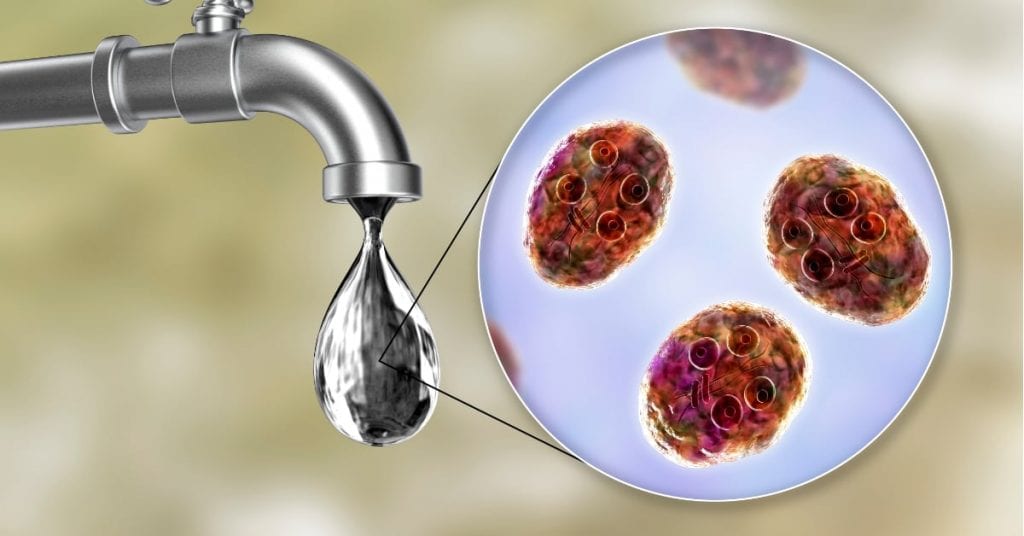
Waterborne diseases
Wherever there is water, there is life in all its forms, plant and animal creatures, microbes, and protozoa. Waterborne diseases transmitted through water are numerous. Near or in the water there is amazing biodiversity. This diversity attracted man to settle and establish civilizations near water sources. Unfortunately, wherever a person is, pollution is found. Man found in renewable waters such as seas and rivers a place to dispose of his waste, thinking that the ability of seas, oceans, and rivers to purify themselves is unlimited. This led to massive pollution in most areas on the globe’s surface, with varying levels and types of pollutants.
Although water occupies the greatest part of the globe, freshwater constitutes only a small part of this large quantity, and of this small part a much smaller part is considered suitable for drinking. Water uses vary from drinking, cleaning, irrigation, recreation, and fishing. Humans produce millions of tons of organic waste, part of which ends up in the water. The sources of this waste can be classified into the human, agricultural and industrial. The danger of this waste depends on its quantity and quality, and the pollutants can be classified into physical, chemical, biological, and compounds that cause allergies.
In this article, we will shed light on the most important microbial pathogens that can be transmitted through water, regardless of the nature of its uses (drinking, irrigation, recreation). One gram of human feces can contain up to 100 billion microbes.
Methods of transmission of waterborne diseases
Diseases acquired through ingestion or the use of contaminated water are known as water-borne diseases. And it has become a privileged place in public health concerns in most countries because of the dangers it poses to large numbers of the population. Water that is contaminated with human or animal waste contains pathogenic microorganisms, which in turn are transmitted to humans or animals through the use of this polluted water, whether for drinking and bathing directly or by contaminating crops that will become food for humans or animals.
According to the World Health Organization reports, about 1.4% of people who have had or are suffering from diarrhea had the caused due to contaminated water. According to the same organization, polluted water (especially groundwater) causes 1.8 million deaths every year. It is estimated that most of these cases result from the mixing of sewage water with pure or fresh groundwater, which leads to contamination with organisms that cause serious diseases. Contaminated water includes microorganisms such as viruses, bacteria, and disease-causing protozoa.
Kingdom’s efforts to treat water
The Kingdom is making every effort to achieve the Kingdom’s Vision 2030, by achieving a sustainable water sector that develops and preserves water resources and preserves the environment. It also provides a secure supply and high-quality and efficient services, which contributes to economic and social development.
This resulted in the completion of projects amounting to more than 45 billion riyals. And spend 90% of the water on agriculture. The Kingdom is the largest producer of desalinated water in the world, accounting for 30% of the world’s production capacity. Because of the huge volume of investments, almost all GCC countries have witnessed, albeit to varying degrees, an increase in the private sector’s contribution to such investments.
Statistics and figures (WHO)
In 2017, 71% of the world’s population (5.3 billion people) used a safely managed drinking water service – i.e. a service that is on-premises, available when needed, and free of pollution.
90% of the world’s population (6.8 billion people) use at least one basic service. The basic service is an improved source of drinking water within a 30-minute round trip to collect water.
785 million people lack even basic drinking water services, including 144 million people who depend on surface water.
Globally, at least two billion people use a drinking water source contaminated with feces.
Contaminated water can transmit diseases such as diarrhea, cholera, dysentery, typhoid, and polio. It is estimated that contaminated drinking water causes 485,000 deaths from diarrhea each year.
By 2025, half of the world’s population will live in water-stressed areas.
In the least developed countries, 22% of healthcare facilities do not have a water service, 21% do not have a sewage service, and 22% do not have a waste management service.
Diseases caused by protozoa
Amoebic dysentery
Sources of microbes in water: sewage, untreated drinking water, flying insects.
Symptoms of infection: abdominal upset, fatigue, weight loss, diarrhea, flatulence, fever.
Cryptosporidiosis
Sources of microbes in water: collected on unsensitized water filters, organic fertilizers, and seasonal running water.
Symptoms of infection: flu-like symptoms, watery diarrhea, loss of appetite, significant weight loss, bloating, increased gas, and nausea.
Cyclophorids
Sources of microbes in water: sewage, untreated drinking water.
Symptoms of infection: muscle cramps, nausea, vomiting, muscle pain, fever, fatigue.
Giardiasis
Sources of microbes in water: untreated water, poor disinfection, pipe breaks, leaks, groundwater contamination, places where humans and wild animals share the same water source.
Symptoms of infection: diarrhea, abdominal pain, bloating, flatulence.
Diseases caused by bacteria
Campylobacteriosis
Sources of microbes in water: Drinking water contaminated with feces.
Symptoms of infection: Dysentery with fever usually lasts from 2-10 days.
Cholera
Sources of microbes in water: Drinking water contaminated with bacteria.
Symptoms of infection: It is one of the fastest-known killer diseases. Symptoms include severe watery diarrhea, nausea, muscle cramps, epistaxis, rapid pulse, vomiting, and hypovolemia (in severe cases). Death can occur in 12-18 hours.
Escherichia coli
Sources of microbes in water: Drinking water contaminated with bacteria.
Symptoms of infection: Diarrhea, which can cause death due to immunodeficiency, in very young and elderly individuals due to prolonged dehydration from the disease.
Otitis externa
Sources of microbes in water: Swimming in contaminated water.
Symptoms of infection: the ear canal swells causing pain, and loss of balance.
Typhoid
Sources of microbes in water: Drinking water contaminated with the feces of an infected person.
Symptoms of infection: persistent fever up to 40 degrees Celsius, profuse sweating, diarrhea may occur, symptoms develop into delirium, and the spleen and liver may enlarge if not treated. In this condition, it can last up to four weeks and cause death. Some people with typhoid fever develop a rash of small red spots on the abdomen and chest.
Diseases caused by viruses
Viral diarrhea
Sources of microbes in water: Drinking or swimming water is contaminated with the excrement of virus infected people.
Symptoms of infection: Diarrhea may be accompanied by abdominal pain.
Meningitis
Sources of microbes in water: Contaminated drinking or swimming water with infected feces.
Symptoms of infection: fever, rash, sore throat, joint pain and headache, and may develop into common meningitis symptoms.
Hepatitis A
Sources of microbes in water: They appear in water and food.
Symptoms of infection: fatigue, fever, abdominal pain, nausea, diarrhea, weight loss, jaundice, and depression (mental condition).
Poliomyelitis
Sources of microbes in water: Water contaminated with the feces of an infected person.
Symptoms of infection: 90-95% of patients do not show any symptoms, 4-8% have mild symptoms (relatively), with delirium, headache, fever, and sometimes seizure, 1% have symptoms of aseptic meningitis other than paralysis, and the rest have serious symptoms Which leads to paralysis or death.
Multiple viral infections
Sources of microbes in water: They can manifest themselves in water, about 80% of people have antibodies to these viruses.
Symptoms of infection: BK virus causes a respiratory infection, and can infect kidney transplant recipients with inhibition. JC virus infects the respiratory tract and kidneys and may cause progressive multifocal leukoencephalopathy of the brain, which is fatal.
The danger of waterborne diseases
This is not a complete list but it does include some waterborne diseases. In light of the global population increase and the increase in the daily share of drinking water per person, the permanent mutation of viruses and the increase in pollution factors, and thus a significant increase in the quantities of wastewater that can pollute drinking water, this raises the alarm for fear of an outbreak of waterborne diseases, especially in light of climate changes. Which would redistribute rainwater in a manner contrary to the current situation. Therefore, this issue must be given great importance because it is a public health issue that affects all humanity.
That is why we always strive to take care of water by providing many services related to water treatment, such as home filters, reverse osmosis plants, and many others services. We also take care of everything related to periodic maintenance and the provision of spare parts of the highest quality and with many choices that suit different needs and different applications.
























